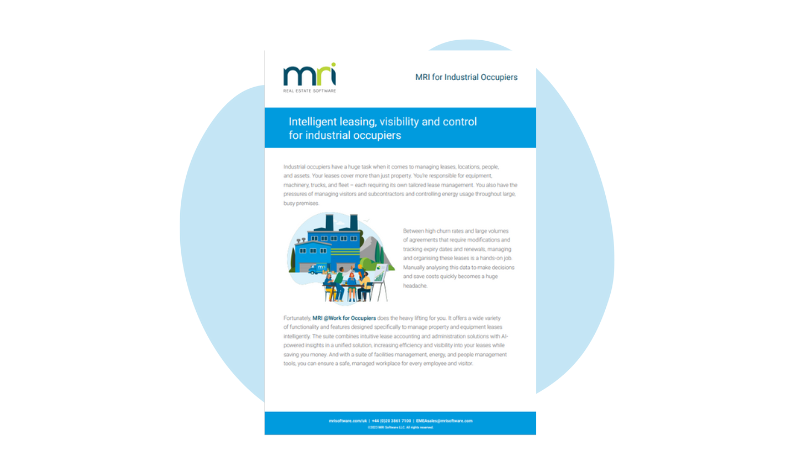Become a data visionary: Four questions to ask your analytical team to future-proof your investment strategies
It’s unlikely that anybody could have predicted the real estate market shifts over the past 12 months. As in many other industries, it’s likely that the landscape is forever changed, and the real estate industry can expect to face some further curve balls in the coming months and years.
To navigate the road ahead, it’s vital that real estate investment management firms have the tools and processes in place to allow for confident decision making and a visionary approach to long-term strategy. All too often, firms’ ability to anticipate and plan for the future is limited by inadequate processes and out-of-date tools.
There’s never been a better time to review your approach to data and analytics, and to ask some tough questions about whether long standing processes are still fit for purpose, or whether they might be holding your most insightful decision makers back.
The discussion points below provide a starting point for identifying gaps in your current analytical approach and implementing changes that will not only allow you to adapt and respond more rapidly to future unforeseen events, but to operate more efficiently and effectively in real-time too.
How much are we spending to report on “what is”?
Historically, the most important challenge for strategic planning was collecting and aggregating data from multiple disparate sources. Early real estate software was typically designed as a closed system with limited connectivity, requiring analysts to output data from property management systems and combine it manually with market data, valuation details and third-party benchmarking sources to provide the core data sets on which to base investment models.
As the market has become more sophisticated, and as investors have become ever more demanding in the granularity of reporting data they expect from their management companies, the workload required just to build these “what’s happening now” data sets manually is overwhelming.
Technology providers have responded to the requirement from their clients for a more connected data ecosystem by investing in API’s and other web services to allow integration between not just systems designed by the same provider, but a much wider range of tools and data sources, from multiple suppliers.
This open and connected ethos opens up significant opportunities for real estate investment firms to save time and improve efficiency in their data gathering and base case reporting. By increasing the speed at which your team can get a clear picture of “what is”, your team is free to focus on “what will be”.
How many potential points of failure are there in our data analysis process?
Not only does collecting and collating this “base case” data manually in spreadsheets take a disproportionate amount of time, it also introduces multiple points of failure where inaccuracies can creep in. Every human intervention in data processing increases the risk of errors, whether through inaccurate data entry or incorrect modifications to calculation functions in a modelling spreadsheet – and when mistakes do crop up, it’s often near impossible to follow an audit trail to figure out exactly what’s gone wrong.
Errors can build up over time, skewing data and leading to unknown levels of inaccuracy in modelling calculations. There’s a laundry-list of examples of Excel mistakes leading to significant financial and reputational damage for businesses depending too heavily on spreadsheet calculations for major business decisions, from Fidelity’s $2.6 billion mistake when calculating dividend distributions for its Magellan fund to the more recent UK government COVID testing debacle.
Streamlining and automating data gathering is not just a time saver, but a vital risk reduction process. By relying on established, tested software and API’s with a robust audit trail, real estate investment firms can have confidence in the data on which they’re basing critical business decisions.
Are our data team analysts, or just data wranglers?
Data analytics and business intelligence hires are high on the priority list for real estate investment firms, and with good reason – the ability of a company to insightfully analyse data, spot trends and make timely strategic decisions is a key differentiator, and data wizards are rightly regarded as being key to this.
Too often, though, firms bring in talented individuals only to have them hamstrung by convoluted processes and poor-quality data, turning visionary analysts into data wranglers who spend so much time collecting data and reporting on “what is” that they have no time to plan for “what will be”.
As millennials and Gen Z employees enter the workforce, this not only limits companies’ performance but affects their employee engagement and retention, too – younger employees’ expectations for intuitiveness, integration and user experience are sky-high as standard, and employers who don’t supply the right toolkit can struggle to retain talented new hires, particularly as younger generations already expect to switch jobs more frequently than their older colleagues.
For real estate investment managers, identifying the appropriate suite of technology to minimise resource usage on rote data management allows analysts to focus their energies on building the most realistic, profitable and successful strategic plan for your portfolio – getting the maximum value out of their data teams and keeping them engaged and productive.
How long does it take to remodel our projections for a new scenario?
Having the right data management tools in place gives real estate investment managers the agility to pivot in the face of changing situations – whether COVID-level or more commonplace. Just as firms should be relying on technology to map, aggregate, normalise and report on data, they must also look to technology to streamline their processing calculations.
In the bad old days of Excel-based investment modelling, it could take a team of analysts weeks to produce financial and strategic plans based on a specific set of assumptions. Should the board then wish to explore a slightly different set of assumptions, the entire process started again, meaning that by the time insight was available, the opportunity had most likely passed.
With modern business intelligence and modelling tools such as MRI Investment Modelling, AI and robotic process automation can make short work of these types of calculations, reducing the time required to adjust scenarios from weeks to mere minutes. Not only do these systems provide data that’s more reliable and less error-prone, they also put critical business insights in front of senior teams quickly, allowing them to take decisive action and maximise new opportunities.
Become a RE:Visionary with MRI
At MRI, we know that our customers need robust, connected software solutions to achieve their strategic objectives, leveraging cutting-edge technology to become true data visionaries. Get in touch find out more about how our solutions can help you streamline processes, connect your tech, and ultimately unleash the visionary in you.
This blog was originally featured in the EG UK Cities Investor Guide 2021, published 3, June 2021. Read more here.
Simplify the complexity of industrial and logistics real estate investment
From navigating lease administration and accounting to maintaining facilities and exceeding tenant satisfaction, managing industrial and logistics real estate portfolios is complex and demanding work. It becomes even more challenging when your busine…

